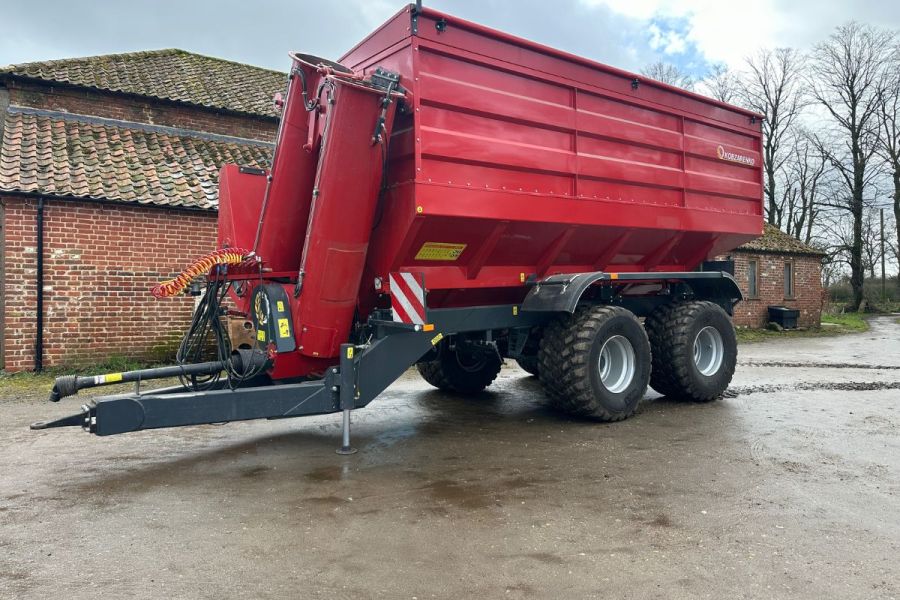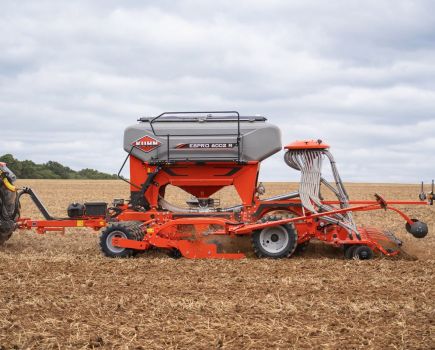There’s hardly enough time, hands or weather windows during harvest to go around, meaning everything can become rather stretched. CPM explores how investing in a chaser bin could improve timeliness, staff distribution and help consolidate capital expenditure as this busy season approaches.
“With a chaser bin it can help trim down on trailers, redistribute staff and increase the productivity of combines.” – MARTIN JENSON
By Melanie Jenkins
It may only be spring now, but it won’t be long before fields are full of combines and the roads are busy with the cycle of tractors carting grain. But what if operations could be streamlined via one simple addition to the farm’s machinery line-up?
Chaser bins may not be a regular sight on UK farms, but their popularity is increasing as the benefits they can bring to busy operations are realised. After buying a Kobzarenko chaser bin for his operations a few years back and seeing how useful it was to his own business, Martin Jenson has now expanded into importing them to sell in England.
“The direction UK farming is headed means there are increasingly larger farms or contracting businesses,” he says. “Although farms in England aren’t large-scale in the way some are in other parts of the world, the expansion here means travelling greater distances to transport grain with tractors and trailers.
“But it’s not always feasible to transport grain with a tractor and trailer, which combined, could cost £100,000. But with a chaser bin, this offers another leg to operations that can help businesses to trim down on trailers, redistribute staff and increase the productivity of their combines,” he explains.
BUSINESS VENTURE
Martin operates several farms with one based in Norfolk, another in Cambridgeshire and a third in Ukraine. His latest venture into chaser bins includes importing and selling them, as well as providing the option to rent at a day rate, for a season or a year.
“Not only did I see the scope of use, I also felt they were likely to become a necessity for some farmers, especially those operating across more than 1500ha. Chaser bins are here to stay and I think we’ll see more of them on UK farms every year.
“For us, adding a chaser bin to our system was the first step towards introducing controlled traffic farming (CTF). Although we aren’t fully CTF across the holdings, we’ve gone into it by degrees and are at the point where we’ve renewed our entire cultivation fleet to tie it all up – but we’ve had to do this incrementally because of the costs involved.”
OPERATIONAL SAVINGS
The decision to go in this direction was made to reduce compaction and improve operational savings. “We’d studied chaser bins operating on other farms before investing ourselves, and having looked at all the different manufacturers available throughout Europe, we settled on Kobzarenko. Now having run one myself, I can vouch for the quality of the equipment.”
Kobzarenko has the widest range of chaser bins in Europe – from 9-50m³ / 7-40t – with the smallest even likely to appeal to pig farmers for moving feed. “The range on offer was something that I really liked,” says Martin. “Not just the quality of the products but the volume of machines the firm manufactures, as well as the price point. For example, the 24t machine is on the market for £30,000 less than a competitor’s equivalent.”
For those familiar with chaser bins, most manufacturers offer similar features across the board, such as the option of cell weighing, but Kobzarenko’s machines have hydraulic sliding gates which open at the bottom and feed grain into the auger, and the feed can be adjusted when loading seeding machines. It’s also possible to fit several magnetic cameras onto the body of the machine to aid with health and safety.
“One thing I like about Kobzarenko’s chaser bins is that they have the added advantage of an auger extension – up to 5.5m – giving it capacity for a wider range of uses,” says Martin. “The extended length means the chaser bin has further use in the autumn and spring because it can empty into seed drills in bulk.
“Rather than having to load 12t of seed into a trailer and move this with a telehandler or tractor, you can just empty 18t of seed directly into the drill. Alternatively, the extended augers could be used for bulk fertiliser which helps reduce handling. Whereas a chaser bin could spend nine out of 12 months in the shed, this opens up the possibilities for using it throughout the year.”
Plus, the range of crops that it can handle works for any system, highlights Martin, having used his chaser bin for a wide variety including maize. “I don’t think there’s anything I’m aware of that it couldn’t handle.”
He recommends they’re stored indoors and notes it’s pertinent to wash them out after they’ve finished being used for a specific purpose, especially if it’s had fertiliser through it. “It’s not high maintenance but it’s advisable to wash it out, removing grit from bearing areas and using a knapsack system to thinly spray oil on the turning parts.”
Additionally, before delivery, all Kobzarenko machines are sent to a local firm for brake testing to ensure they’re safely operational ahead of use. And for those who prefer a colour-coordinated fleet, the chaser bins can be specified in any colour.
When making the decision on whether to invest in a chaser bin, Martin believes it’s down to the amalgamation of benefits. “They can help reduce soil compaction, saving on cultivation costs; can help limit capital expenditure; provide diversified usage and increase the operational capacity of combines. If you could increase your combine’s productivity by 10-15% then this equals a huge saving in capital expenditure and operational savings.
“For those looking to hire a machine, this can be a stepping-stone to determine how one might fit into your business. Most people who hire one come to the conclusion that they can’t manage without one,” he concludes.
This article was taken from the latest issue of CPM. Read the article in full here.
For more articles like this, subscribe here.
Sign up for Crop Production Magazine’s FREE e-newsletter here.




